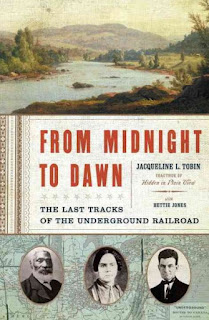 Sometimes titles deceive. In choosing From Midnight to Dawn: The Last Tracks of the Underground Railroad as her title, Jacqueline L. Tobin has shortchanged her book, which is about much more than the transport of escaped American slaves before the Civil War. Instead, she depicts racial conditions in various regions before the war and explains how regional differences destabilized the continent. She tells about the abolitionist movement and the press it spawned, the passing of the Fugitive Slave bill and its application (or lack of) in various states, organizations to aid fugitives once they reach free lands, and the development of black communities in Canada. Her book is more about the context in which the Underground Railroad ran than about the running of the Railroad.
Sometimes titles deceive. In choosing From Midnight to Dawn: The Last Tracks of the Underground Railroad as her title, Jacqueline L. Tobin has shortchanged her book, which is about much more than the transport of escaped American slaves before the Civil War. Instead, she depicts racial conditions in various regions before the war and explains how regional differences destabilized the continent. She tells about the abolitionist movement and the press it spawned, the passing of the Fugitive Slave bill and its application (or lack of) in various states, organizations to aid fugitives once they reach free lands, and the development of black communities in Canada. Her book is more about the context in which the Underground Railroad ran than about the running of the Railroad.What does it matter? Well, student looking for escape stories or descriptions of the routes taken by fugitives will be disappointed by Tobin's book. There are, however, many other books with these stories. What the author contributes to the literature are stories of the black communities in Canada, like Buxton, Sandwich, Wilberforce, and Dawn. Getting to Canada was not the end of the story. The fugitives did not all live happily ever after. There were hard winters, lands to plow, good and bad neighbors, bills to pay, rights to be earned. Abolitionists in the U.S. spent much time reporting on and debating the merits of these communities. Should they send aid or would blacks better learn self-reliance if they got no aid? Should free blacks receive the same help as fugitives? What agreements went with the aid, such as temperance or church attendance? Could the communities serve as models for forming black communities in the South after Emancipation?
Readers of From Midnight to Dawn learn much about the abolitionist press, which was far from united in mission. Some writers really wanted all the blacks sent back to Africa. Opinions about Harriet Beecher Stowe's Uncle Tom's Cabin and about John Brown's attack on Harper's Ferry varied. The role of women in abolition was also debated. Ironically, not much was said by abolitionists about the Underground Railroad, which needed secrecy to survive the Fugitive Slave Law.
Readers who think the 21st Century is remarkable for its communities divided by controversies need only read this book to see that nothing is new. Look for it in public libraries.
Tobin, Jacqueline L. From Midnight to Dawn: The Last Tracks of the Underground Railroad. Doubleday, 2006. ISBN 038551431X



No comments:
Post a Comment